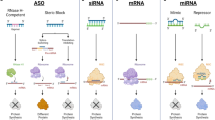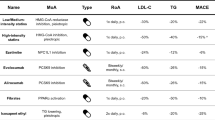Abstract
Patients with genetically associated elevated lipoprotein(a) [Lp(a)] levels are at greater risk for coronary artery disease, heart attack, stroke, and peripheral arterial disease. To date, there are no US FDA-approved drug therapies that are designed to target Lp(a) with the goal of lowering the Lp(a) level in patients who have increased risk. The American College of Cardiology (ACC) has provided guidelines on how to use traditional lipid profiles to assess the risk of atherosclerotic cardiovascular disease (ASCVD); however, even with the emergence of statin add-on therapies such as ezetimibe and proprotein convertase subtilisin/kexin type 9 (PCSK9) inhibitors, some populations with elevated Lp(a) biomarkers remain at an increased risk for cardiovascular (CV) disease. Residual CV risk has led researchers to inquire about how lowering Lp(a) can be used as a potential preventative therapy in reducing CV events. This review aims to present and discuss the current clinical and scientific evidence pertaining to pelacarsen.


Similar content being viewed by others
Change history
11 December 2021
A Correction to this paper has been published: https://doi.org/10.1007/s40256-021-00513-6
References
World Health Organization. WHO; 2021. https://www.who.int/cardiovascular_disease/world-heart-day/en/. Accessed 22 Apr 2021.
Willeit P, Ridker PM, Nestel PJ, et al. Baseline and on-statin treatment lipoprotein(a) levels for prediction of cardiovascular events: individual patient-data meta-analysis of statin outcome trials. Lancet. 2018;392(10155):1311–20.
Wilson DP, Jacobson TA, Jones PE, et al. Use of Lipoprotein(a) in a clinical practice: a biomarker whose time has come A scientific statement from the National Lipid Association. J Cli Lipidol. 2019;13:374–92.
Arnett DK, Blumenthal RS, Albert A, Buroker AB, Goldberger ZD. 2019 ACC/AHA guideline on the primary prevention of cardiovascular disease. J Am Coll Cardiol. 2019;74(10):e177-232.
Mach F, Baigent C, Catapano AL, Koskinas KC, Casula M, Badimon L. 2019 ESC/EAS Guidelines for the management of dyslipidaemias: lipid modification to reduce cardiovascular risl: The Task Force for the managment of dyslipideaemias of the European Society of Cardiology (ESC) and European Atherosclerosis Society (EAS). Eur Heart J. 2020;41(1):111–88.
O’Donoghue ML, Fazio S, Giugliano RP, Stroes ESG, Kanevsky E, Gouni-Berthold I. Lipoprotein(a), pcsk9 inhibition, and cardiovascular risk insights from the FOURIER Trial. Circulation. 2019;139:1483–92.
Sabatine MS, Giugliano RP, Keech AC, et al. Evolocumab and clinical outcomes in patients with cardiovascular Disease. N Engl J Med. 2017;376(18):1713–22.
Fazio S, Edmiston JB, Brooks N, et al. Discordant response of low-density lipoprotein cholesterol and lipoprotein(a) levels to monoclonal antibodies targeting proprotein convertase subtilisin/kexin type 9. J Clin Lipidol. 2017;11(3):667–73.
Steikema LCA, Prange KHM, Hoogeveen RM, et al. Potent lipoprotein(a) lowering follwing apolipoprotein(a) antisense treatment reduces the pro-inflammatory activation of circulating monocytes in patients with elevated lipoprotein(a). Eur Heart J. 2020;41:2262–71.
Schmidt K, Noureen A, Kronenberg F, Utermann G. Structure, function, and genetics of lipoprotein(a). J Lipid Res. 2016;57:1339–59.
Coassin S, Kronenberg F. Mechanistic insight into lipoprotein(a): from infamous to “inflammous.” Eur Heart J. 2020;420(41):2272–4.
Kronenberg K, Utermann G. Lipoprotein(a): resurrected by genetics. J Intern Med. 2013;273(1):6–30.
Lamina C, Kronenberg F. Therapeutic effect size of reduction in coronary heart disease outcomes. A Mendelian Randomization Analysis. JAMA Cardiol. 2019;4(6):575–9.
Thanassoulis G. Lipoprotien(a) in calcific aortic valve disease: from genomics to novel drug target for aortic stenosis. J Lipid Res. 2016;57:917–24.
Erqou S, Thompson A, Angelatonio ED, et al. Apolipoprotein(a) isoforms and the risk of vascular disease: systematic review of 40 studies involving 58,000 partcipants. J Am Coll Cardiol. 2010;55(19):2160–7.
Schwartz GG, Steg PG, Szarek M, Bittner VA, Diaz R. Peripheral artery disease and venous thromboembolic events after acute coronary syndrome, Role of Lipoprotein(a) and modification by alirocumab: prespecified analysis of the ODYSSEY OUTCOMES randomized clinical trial. Circulation. 2020;141:1608–17.
Patel AP, Wang M, Pirruccello P, et al. Lp(a) (Lipoprotein[a]) concentrations and incident atherosclerotic cardiovascular disease. Atheroscler, Thromb Vasc Biol. 2021;41:465–74.
Jang AY, Han SH, Sohn S, Oh PC, Koh KK. Lipoprotein(a) and cardiovascular diseases. Revisited. Circ J. 2020;84:867–74.
Schwartz GG, Steg PG, Szarek M, Bhatt DL, Bittner VA. Alirocumab and cardiovascular outcomes after acute coronary syndrome. N Engl J Med. 2019;379(22):2097–107.
Fernandez-Prado R, Perez-Gomez MV, Ortiz A. Pelacarsen for lowering lipoprotein(a): implications for patients with chronic kidney disease. Clin Kidney J. 2020;13(5):753–7.
Tsimikas S, Karwatoska-Prokopczuk E, Gouni-Berthold I, et al. Lipoprotein(a) reduction in persons with cardiovascular disease. N Engl J Med. 2020;382(3):244–55.
Ruscica M, Greco MF, Ferri N, Corsini A. Gender difference in lipoprotein(a) concentration as a predictor of coronary revascularization in patients with known coronary artery disease. Eur Heart J. 2020;22(Suppl L):L53–6.
Goyal N, Narayanaswami P. Making sense of antisense oligionucleotides: a narrative review. Muscle Nerve. 2017;57(3):356–70.
Viney N, Capelleveen JC, Geary RS, Xia S, Tami JA, Yu RZ. Antisense oligionucleotides targeting apolipoprotein(a) in people with raised lipoprotein(a): two randomised, double-blind, placebo-controlled, dose-ranging trials. The Lancet. 2016;388:2239–53.
Tsimikas S, Viney NJ, Hughes SG. Antisense therapy targeting apolipoprotein(a): a randomised, double-blind, placebo-controlled phase 1 study. The Lancet. 2015;386:1472–83.
Tsimikas S. The re-emergence of lipoprotein(a0 in a broader clinical arean. Prog Cardiovasc Dis. 2016;59:135–44.
Novartis Pharmaceuticals. Assessing the impact of lipoprotein(a) lowering with TQJ230 on major cardiovascular events in patients with CVD (Lp(a)HORIZON). National Institutes of Health, US National Library of Medicine. ClinicalTrials.gov. https://clinicaltrials.gov/ct2/show/NCT04023552?term=tqj230&draw=2&rank=1. Accessed 28 Apr 2021.
Koren MJ, Moriarty PM, Neutel J, Baum SJ, Hernandez-Illas M. Abstract 13951: safety, tolerability and efficacy of single-dose AMG 890, a novel Sirna Targeting Lp(a), in healthy subjects and subjects with elevated Lp(a). Circulation. 2020;142(Suppl 3:A13951.
Stiekema LCA, Prange KHM, Hoogeveen RM, Verweij S, Kroon J. Potent lipoprotein(a) lowering following apolipoprotein(a) antisense treatment reduces the pro-inflammatory activation of circulating monocytes in patients with elevated lipoprotein(a). Eur Heart J. 2020;41(24):2262–71.
Burgess S, Ference BA, Staley JR, Freitag DF, Mason AM. Association of LPA variants with risk of coronary disease and the implications for lipoprotein(a)-Lowering therapies. A Mendelian randomization analysis. JAMA Cardiol. 2018;3(7):619–617.
Madsen CM, Kamstrup PR, Langsted A, Varbo A, Nordestgaard BG. Lipoprotein(a)-lowering by 50 mg/dL (105 nmol/L) may be needed to reduce cardiovascular disease 20% in secondary prevention. Atherioscler Thromb Vasc Biol. 2020;40:255–66.
Benizri S, Gissot A, Martin A, Vialet B, Grinstaff MW. Bioconjugated oligionucelotides: recent developments and therapeutic applcations. Bioconjug Chem. 2019;30(2):366–83.
Author information
Authors and Affiliations
Corresponding author
Ethics declarations
Funding
No external funding was used in the preparation of this manuscript.
Conflicts of interest
Jennifer Hardy, Stephanie Niman, Rebecca F. Goldfaden, Majdi Ashchi, Mohannad Bisharat, Jessica Huston, Heather Hartmann, and Rushab Choksi declare they have no conflicts of interest that might be relevant to this manuscript.
Availability of data and material
Not applicable.
Ethics approval
Not applicable.
Code availability
Not applicable.
Consent to participate
Not applicable.
Consent to participate
Not applicable.
Author contributions
All authors contributed to the review. Rebecca Goldfaden had the idea for the article; Jennifer Hardy, Stephanie Niman, and Heather Hartmann performed the literature search and data analysis; and all authors drafted and/or critically revised the review. All authors read and approved the final manuscript.
Additional information
The original Online version of this article was revised: The Figure 2 was inadvertently published as Figure 2a and 2b.
Rights and permissions
About this article
Cite this article
Hardy, J., Niman, S., Goldfaden, R.F. et al. A Review of the Clinical Pharmacology of Pelacarsen: A Lipoprotein(a)-Lowering Agent. Am J Cardiovasc Drugs 22, 47–54 (2022). https://doi.org/10.1007/s40256-021-00499-1
Accepted:
Published:
Issue Date:
DOI: https://doi.org/10.1007/s40256-021-00499-1




